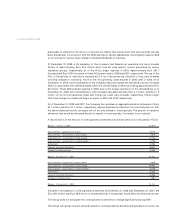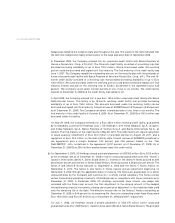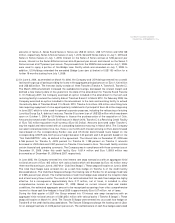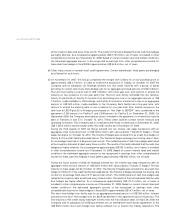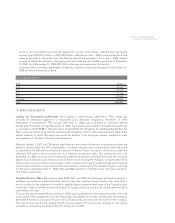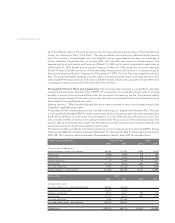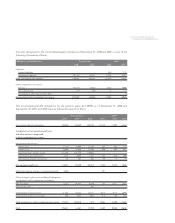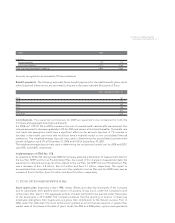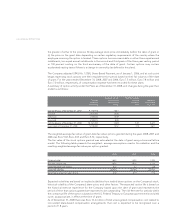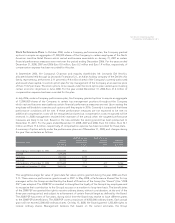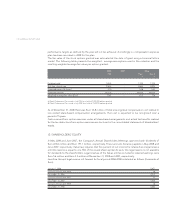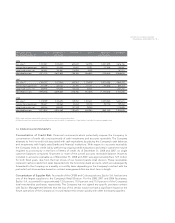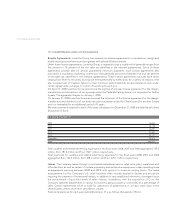LensCrafters 2008 Annual Report Download - page 87
Download and view the complete annual report
Please find page 87 of the 2008 LensCrafters annual report below. You can navigate through the pages in the report by either clicking on the pages listed below, or by using the keyword search tool below to find specific information within the annual report.
The Lux Plan’s investment policy defines the target allocation as mentioned in the above table as well as
a range of possible allocations. The range of allocation to equity securities is 58% to 72% and the range
of allocation to debt securities is 32% to 38%. The actual allocation percentages at any given time may vary
from the targeted amounts due to changes in stock and bond valuations as well as timing of contributions
to, and benefit payments from, the pension plan trusts. Beginning in September 2008, the global capital
markets took a downward turn and have since become extremely volatile. This volatility is evident in the
year-end market values of plan assets. Upon direction from the plan’s administrator, the Luxottica Group’s
Employee Retirement Income Security Act of 1974 (“ERISA”) Plans Compliance and Investment
Committee, it was decided to refrain from an actual rebalancing of the plan’s assets until the markets
become more stable.
Plan assets are invested in diversified portfolios consisting of an array of asset classes within the above
target allocations and using a combination of active strategies. Active strategies employ multiple
investment management firms. Risk is controlled through diversification among asset classes, managers,
styles, market capitalization (equity investments), and individual securities. Certain transactions and
securities are not authorized to be conducted or held in the pension trusts, such as ownership of real
estate other than real estate investment trusts, commodity contracts, and American Depositary Receipts
(“ADRs”) or common stock of the Company. Risk is further controlled both at the asset class and manager
level by assigning benchmarks and excess return targets. The investment managers are monitored on an
ongoing basis to evaluate performance against the established market benchmarks and return targets.
The defined benefit pension plans have an investment policy that was developed to serve as a
management tool to provide the framework within which the fiduciary’s investment decisions are made,
establish standards to measure investment manager’s performance, outline the roles and responsibilities
of the various parties involved, and describe the ongoing review process.
Benefit Payments. The following estimated future benefit payments, which reflect expected future
service, are expected to be paid in the years indicated (thousands of Euro):
NOTES TO CONSOLIDATED
FINANCIAL STATEMENTS |85 <
Pension Supplemental
plan plans
2009 10,677 442
2010 11,314 560
2011 12,395 558
2012 13,670 948
2013 15,276 1,179
2014-2018 92,668 4,746
Contributions. The Company expects to contribute Euro 26.9 million to its pension plan and Euro 0.4
million to the SERP in 2009.
Other benefits. The Company provides certain postemployment medical, disability, and life insurance
benefits. The Company’s accrued liability related to this obligation as of December 31, 2008 and 2007, was
Euro 1.6 million and Euro 1.4 million, respectively, and is included in other long term liabilities on the
consolidated balance sheets.
The Company sponsors a tax incentive savings plan covering all full-time employees. The Company makes
quarterly contributions in cash to the plan based on a percentage of employees’ contributions.
Additionally, the Company may make an annual discretionary contribution to the plan, which may be made
in the Parent Company’s ADRs or cash. Aggregate contributions made to the tax incentive savings plan by
the Company were Euro 8.8 million and Euro 8.1 million for fiscal 2008 and 2007, respectively. For fiscal
2008 and 2007, these contributions did not include a discretionary match.



